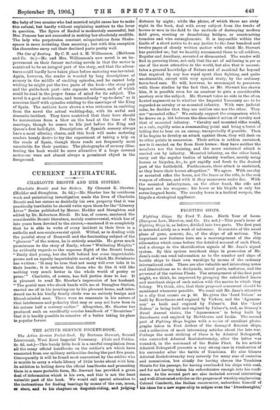THE ACTIVE SERVICE POCKET-BOOK.
The Active Service Pocket-Book. By Bertram Stewart, Second Lieutenant, West Kent Imperial Yeomanry. (Gale and Polden. 2s. 6d. net.)—This handy little book is a careful compilation from all the many official handbooks on the soldier's art which have emanated from our military authorities during the past five years. Consequently it will be found most convenient by the soldier who is unable to carry a whole library of little books about with him. In addition to boiling down the official handbooks and presenting them in a mere portable form, Mr. Stewart has provided a great deal of information which is his own, and this is not the least valuable part of the book. We would call special attention to the instructions for finding bearings by means of the sun, moon, ea stars, and to his chapters on despatch-riding, and judging distance by night; while the plates, of which there are Bixby eight in the book, deal with every subject from the tracks of horses or men in the field to the methods of destroying modern field guns, erecting or demolishing bridges, or constructing trenohes and wire entanglements. It is impossible within the limits of a short notice to do any justice to the four hundred and twelve pages of closely written matter with which Mr. Stewart has provided us; but we heartily recommend them to all soldiers, Regular and Auxiliary, mounted or dismounted. The reader will find in perusing them, not only that the art of soldiering is per as one of the most attractive in the world, but also that it necessi- tates a general knowledge of Nature and of mankind far beyond that required by any loss royal sport than fighting, and quite unattainable, except with very special study, by the ordinary town-bred man. He will, however, be encouraged to persevere with those studies by the fact that, as Mr. Stewart has shown him, it is possible even for an amateur to gain a considerable mastery over the subject. Mr. Stewart takes no side in the often heated argument as to whether the Imperial Yeomanry are to be regarded as cavalry or as mounted infantry. With rare judicial calm, he decides that they are neither one nor the other. They are "mounted rifles." We entirely support the comparison which he draws on p. 164 between the dismounted action of cavalry and that of mounted infantry. "Cavalry and mounted rifles would, as a rule, rapidly seize a commanding point and bring a burst of telling fire to bear on an enemy, unexpectedly if possible. Then if he begins to develop an attack against them, they will dash on to other points in succession. Their action is seldom sustained, nor is it carried on far from their horses : they have neither the numbers nor the training, and the more sustained attack is carried out by infantry. Mounted infantry, on the other hand, carry out the regular tactics of infantry warfare, merely using horses or bicycles, &c., to get rapidly and fresh to the desired part of the battlefield. Furthermore, their attack is sustained, as they leave their horses altogether." We agree. With cavalry or mounted rifles the horse, not the lance or the rifle, is tho real weapon of offence, and with it they manceuvre under fire. With the mounted infantryman, on the other hand, the rifle and bayonet are his weapons : his horse or his bicycle is only his seven-leagued boots. The cavalry horse is a tactical weapon, the bicycle a strategical appliance.










































 Previous page
Previous page